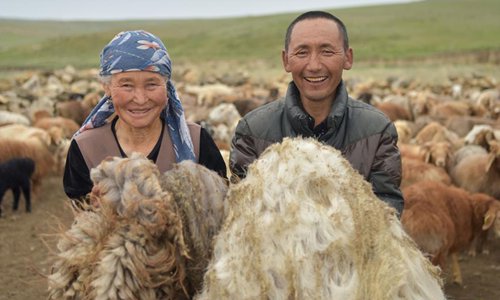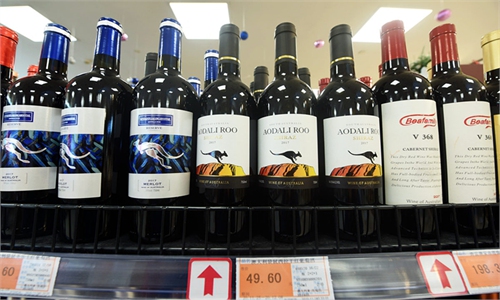
People show wool in Fuhai County of Atlay, northwest China's Xinjiang Uygur Autonomous Region, on June 7, 2019. Photo: Xinhua
Chinese businesses and experts are looking at alternative import sources to lower the risks of the country's dependence on Australian wool.
Bilateral trade between China and Australia soured after the Morrison administration's reckless obstruction of relations. With the trade of several products from Australia ranging from wine to coal and hay encountering hurdles, businesses and experts believe that reducing dependence on Australian agricultural products including wool, which accounts for at least 80 percent of China's wool imports, is necessary to secure the supply chain.
A Xinjiang-based textile company told the Global Times that it now imports only small volumes of wool from Australia compared with locally sourced goods, which make up the majority of its supplies.
"Why should we import [from Australia], when we can find what we need nearby?" said a manager with the company. It's also cheaper to buy and ship domestic wool, the person said.
Delays caused by pandemic-induced logistics disruptions are also pushing Chinese traders to seek more sources.
"Normally, it's a quick two-week turnaround -- now there are delays of between7 to 20 days to China," Dubbo-based wool broker Don McDonald said, noting the congestion in shipping, particularly around Singapore, is the cause of the delays, according to an Australian Broadcasting Corp report on March 23.
The broker said that the delays mainly affect Australian exporters, and they may start buying less wool as a consequence, the report said.
A source surnamed Chen at a large textile company based in Jiangsu Province told the Global Times on Wednesday that almost all of the wool that the company uses comes from Australia.
The company's wool stockpiles are adequate at the moment, but if there are further logistics difficulties, it will look at other options to protect its supply chain, said Chen.
China's demand for wool contributed to the jump in imports including from Australia. China increased its import quota for Australian wool from 36,465 tons last year to 38,288 tons for 2021, according to an official statement.
However, as Chinese businesses diversify their supplies, a concern for Australian producers is wool from countries such as New Zealand, which may quickly grab the market share from Australia, especially after China and New Zealand's new agreement to upgrade their Free Trade Agreement in January, industry insiders said.
Kazakhstan has also been looking to expand its share of the Chinese wool market in 2021, media reports said.
China is diversifying its import sources via deepening cooperation with other sources, particularly under the Belt and Road Initiative, to secure its economic interests, Song Wei, an associate research fellow at the Chinese Academy of International Trade and Economic Cooperation, told the Global Times on Wednesday.
China's major imports from Australia are raw materials, which reflect China's industrial structure and its position in the global value chain. The situation will change after China's industrial structure upgrade, said Song.


